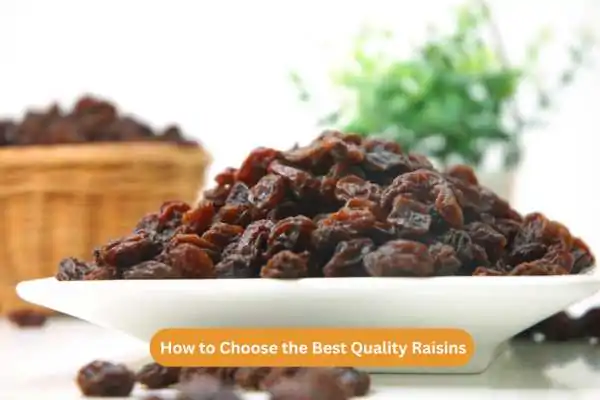Raisins are a staple in many UK households, valued for their natural sweetness, versatility, and nutritional benefits. Whether you enjoy them as a healthy snack, bake them into cakes, or sprinkle them over porridge, choosing the best quality raisins ensures better flavour, texture, and overall satisfaction. But with so many varieties available on supermarket shelves and in health food shops, how do you know which raisins are worth your money?

This guide will walk you through how to choose the best quality raisins—from understanding different types to assessing freshness, origin, and packaging. Making informed choices will not only enhance your recipes but also support a healthier lifestyle.
Understand the Different Types of Raisins
Not all raisins are created equal. The type of raisin you choose can greatly impact your culinary experience. Here are the most common varieties available in the UK:
-
Sultanas: Light golden in colour and made from seedless green grapes. They are typically softer and sweeter than other types.
-
Currants: Small, dark, and tangy, these are made from Black Corinth grapes. Popular in baking, especially in traditional UK recipes.
-
Flame Raisins: Larger and juicier, flame raisins are made from red grapes and have a robust, fruity flavour.
-
Golden Raisins: Treated with sulphur dioxide to preserve their bright colour, golden raisins are plumper and often more tender.
Knowing which type suits your needs helps you narrow down your choices and choose quality over convenience.
Check for Colour and Appearance
High-quality raisins should have a uniform colour, whether they are golden, dark brown, or black. Here’s what to look out for:
-
Avoid unevenly coloured or overly dark raisins, which may indicate poor drying or ageing.
-
Plumpness is a good sign—raisins that are overly dry or shrivelled may be stale.
-
A slight sheen is normal, especially if a small amount of oil is used during packaging, but they should not be greasy or sticky.
Inspecting raisins visually is one of the quickest ways to assess their freshness and quality.
Feel the Texture
If possible, check the texture before buying, especially when purchasing from loose bins or bulk sections:
-
Fresh raisins should feel soft, pliable, and moist, not hard or brittle.
-
Avoid clumped raisins, as they may indicate exposure to moisture or poor storage conditions.
-
A good raisin will bounce back slightly when pressed between your fingers.
Packaged raisins can’t always be touched, but choosing brands with transparent packaging lets you assess them visually.
Read the Ingredient List
When buying packaged raisins, always take a moment to read the label. The best quality raisins typically contain:
-
100% raisins with no added sugars or artificial preservatives.
-
Sun-dried or naturally dried indicators suggest minimal processing.
-
Sulphite-free if you are sensitive to additives like sulphur dioxide.
Avoid raisins with added syrups, colours, or unnecessary oils unless clearly stated as part of a recipe or blend.
Consider the Origin
The origin of raisins can impact their taste, texture, and ethical sourcing. Some of the top sources for high-quality raisins include:
-
Turkey: Known for producing premium sultanas and golden raisins.
-
Iran: Offers naturally dried and traditionally cultivated varieties.
-
USA (California): One of the largest exporters of flame raisins and sun-dried options.
-
South Africa and Chile: Also produce quality raisins often found in UK health stores.
Where possible, opt for organic or Fairtrade-certified raisins, especially if you’re conscious about sustainable farming and ethical labour practices.
Pay Attention to Packaging
Packaging plays a key role in preserving the freshness of raisins. Look for the following:
-
Airtight, resealable bags or vacuum-sealed packs help prevent moisture entry and oxidation.
-
Opaque packaging protects against light exposure, which can degrade nutrients and affect flavour.
-
Clear ‘best before’ dates indicate shelf life and should be well into the future at the time of purchase.
If you prefer buying in bulk, be sure the store maintains proper hygiene standards and that the bins are covered and cleaned regularly.
Storage Tips After Purchase
Even the best quality raisins can deteriorate if not stored properly. Here are a few quick tips:
-
Store in an airtight container in a cool, dark place.
-
Refrigerate or freeze if you buy in bulk or won’t consume them quickly.
-
Avoid exposure to humidity, which can lead to mould or spoilage.
Correct storage maintains both flavour and nutritional value over time.
Final Thoughts
Selecting the best quality raisins isn’t complicated once you know what to look for. From the type and origin to packaging and texture, each factor plays a part in ensuring you get the most out of this naturally sweet and healthy snack. For UK shoppers, the key lies in being mindful, reading labels, and choosing suppliers that prioritise freshness and quality.
Whether you’re baking a traditional spotted dick, mixing a hearty muesli, or just looking for a wholesome snack, investing in good-quality raisins can make all the difference. Let your next handful of raisins be not just tasty, but top-tier in every way.

